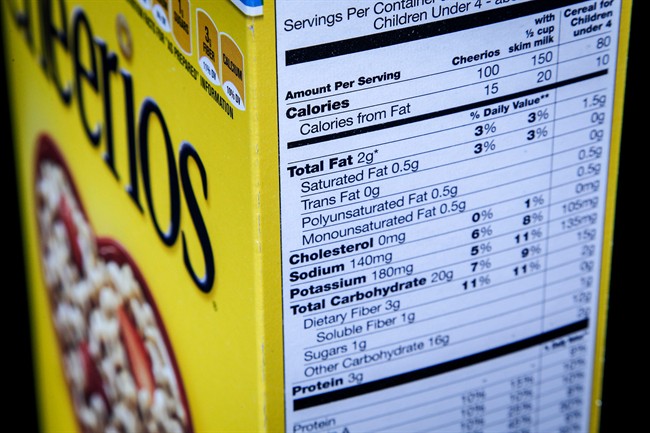Consumers often complain that nutrition facts labels are confusing and misleading, causing them to overeat or misunderstand a proper portion size.

Health officials in Canada and the United States have spent years reworking food labels so they’re easier to understand.
The U.S. Food and Drug Administration rolled out its new nutrition facts panel, outlining a string of changes that’ll ideally help consumers make wiser choices with their eating.
READ MORE: What Health Canada’s ‘easier to read’ nutrition labels would look like
“The ‘iconic’ look of the label remains, but we are making important updates to ensure consumers have access to the information they need to make informed decisions about the foods they eat,” the health officials say in guidelines explaining the changes.
Here’s everything that’s changed on the spruced up U.S. food labels:

Serving sizes
For starters, serving sizes and labelling for certain packages based on size have changed. Was it confusing for you to figure out how many servings was in an entire bag of chips, for example? Hopefully the FDA’s tweaks smooths this out.
Now, by law, serving sizes have to be based on the amount of food and drink people are actually going to eat in a sitting, not what a serving size “should” be.
“How much people eat and drink has changed since the previous serving size requirements were published in 1993,” the FDA notes.
READ MORE: How to read nutrition labels
A serving of ice cream used to be half of a cup in 1993. Now a typical serving is about two-thirds of a cup. A single serving of soda was once eight ounces, but it’s now at 12 ounces, for example.
Package sizes also mislead. Before, a single bag of candy could have two or three servings. Now, a 12-ounce can of soda, or a 15-ounce can of soup has to relay all of the calories and nutrients in the entire product because most people end up eating the entire item in a single sitting.
READ MORE: Change confusing nutrition labels to help consumers, the FDA says
In other cases, “dual columns” have to be laid out so consumers can see what a single serving looks like alongside the entire package’s nutritional values.

Added sugars
Global health officials dropped the gauntlet on added sugars a few years ago when the World Health Organization updated its guidelines so that sugar intake should cap at just five per cent of daily total calories.
Added sugars apply to glucose, fructose, sucrose and even table sugar that’s added to food by the manufacturer, cook or consumer.
READ MORE: How much sugar should you be eating? How to follow the WHO’s guidelines
The thing is, old nutrition labels didn’t separate added sugars from sugar found naturally in food. This time it will, including how much the serving size will contribute to your daily total intake of added sugar.
The FDA notes that it’s sugar-sweetened drinks, such as pop, juice, coffee, and energy drinks, along with snacks and sweets that make up the most of our added sugar intake.
Nutrients phased in, some phased out
Vitamins A and C won’t be on the nutrition facts panel in the U.S. because deficiencies in these categories are rare in the general population, the FDA says. Manufacturers can still list them, but it’s voluntarily.
READ MORE: 6 misconceptions about nutrition and healthy eating
Instead, the health officials are zeroing in on vitamin D and potassium because they’re nutrients the average consumer doesn’t always get enough of. A lack of these vitamins could lead to chronic disease and even tampers with bone health.
Calcium and iron and are staying on the new label.
The label format: Original vs. New
Food manufacturers have until July 26, 2018 to comply to these new changes. But if they’re smaller manufacturers, with less than $10 million in annual sales, they’ll have an extra year to align with these updates.
Read about the full list of changes here.
Health Canada’s own proposed changes are through the online public consultation stages. The updated labels could be introduced some time this year.
Images courtesy the Food and Drug Administration
carmen.chai@globalnews.ca
Follow @Carmen_Chai





Comments